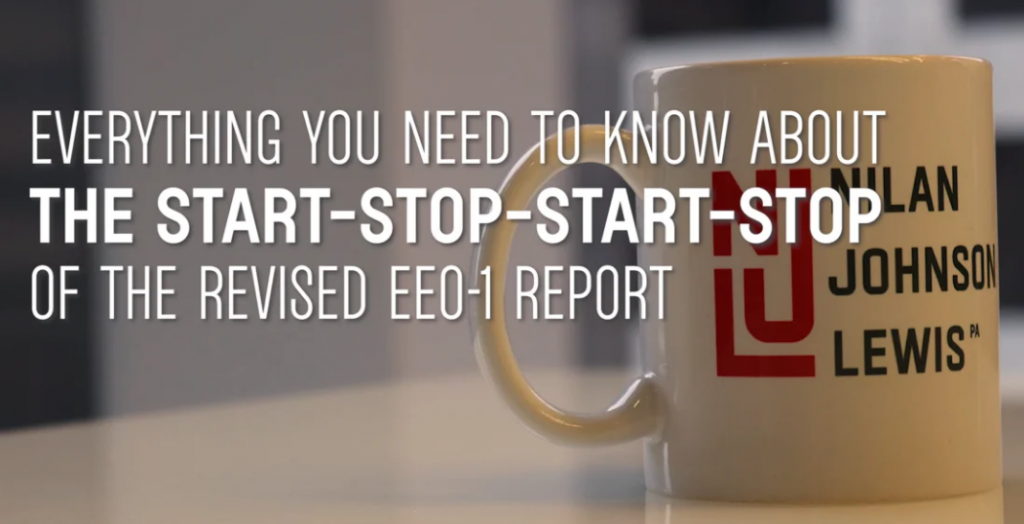
Posted March 1st, 2020 in Top Stories, Legal Insights with Tags The Equal Pay Advisor
A Brief History of the Start-Stop-Start-Stop of the Revised EEO-1 Report
The Brief History
Back on September 29, 2016, mere weeks before Donald Trump would win the 2016 presidential election, the EEOC controversially announced that it would begin to collect summary pay data from employers with 100 or more employees. In support of its decision, then-Chair Jenny R. Yang said, “More than 50 years after pay discrimination became illegal it remains a persistent problem for too many Americans. Collecting pay data is a significant step forward in addressing discriminatory pay practices. This information will assist employers in evaluating their pay practices to prevent pay discrimination and strengthen enforcement of our federal antidiscrimination laws.”
But not even one year later, in August 2017, the Office of Management and Budget (OMB) announced a stay of the summary pay data requirements, just over six months before the first reporting deadline. Still buoyed by the post-election call-to-arms in response to what many regarded as a surprise election, a cadre of like-minded organizations joined forces in November 2017 to initiate a lawsuit challenging the OMB’s stay of the summary pay data reporting deadline. But it wasn’t until early March 2019 that a court issued a decision vacating the stay, and restoring the EEOC’s summary pay data mandate.
Subsequent to the court’s order restoring the requirement, the EEOC announced that it would require employers with 100 or more employees to report summary pay data for calendar years 2017 and 2018—by September 30, 2019.
In response, many employers who had started, then stalled, their efforts to comply with the sweeping new data collection requirement had to reignite their efforts posthaste. For many—especially large—employers, this was a herculean task which required them to identify the appropriate “workforce snapshot period,” and then analyze, by job category, which employees fell into which compensation band, by race/ethnicity and gender. Not surprisingly, collecting this data required many employers to implement new data collection and culling procedures and new analytical approaches—none of which typically happens without significant effort and expense.
And then, almost as suddenly as it reappeared, the revised EEO-1 report disappeared. Again. This time, in September 2019, the EEOC announced that it would not seek approval from the OMB to collect summary pay data going forward. In the wake of the last round of battles, some employers are reluctant to walk back the collection and analysis procedures they implemented for the 2019 report for fear that, like a phoenix, the Revised EEO-1 report will rise yet again.
And the Prognostication
While it is too early to call the 2020 election, it seems unlikely that the Revised EEO-1 report will make a comeback anytime soon. That said, we recommend that employers not let their good work collecting pay equity data go to waste. First and foremost, because it is possible the EEOC might actually do something with the data they collected, it is important for employers to understand what their company reported, in case the EEOC comes knocking with an investigation.
We know the EEOC plans to measure internal pay equity by looking at the distribution between men and women among the 12 reported pay bands. In other words, they are looking to see if women dominate the lower pay bands, while men dominate the higher bands. While the EEOC has recognized that the summary pay data is a blunt tool to assess pay equity, it doesn’t mean they won’t flag an issue based on it. So we recommend that employers take the time to assess for themselves the makeup of employees among the bands and take the opportunity to more comprehensively analyze why any differences exist. This may lead to corrective measures, or it may lead to a thorough explanation of legitimate reasons, other than gender or race, why surface-level differences exist.
Additionally, we do not recommend abandoning the collection and analysis efforts altogether, because we are only at the beginning of a long road to pay equity. There are new state pay equity laws coming online with each year, and it is a trend we see continuing into the future. Not only that, but pay equity litigation in the wake of #MeToo is on the rise. For those reasons, keeping up tracking and analysis of pay equity is a good practice regardless of the EEOC’s reporting requirements. But we recommend that employers do so in partnership with their legal counsel, to cloak that collection and analysis in the attorney-client privilege.
